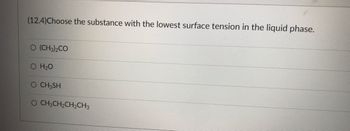
Chemistry
10th Edition
ISBN: 9781305957404
Author: Steven S. Zumdahl, Susan A. Zumdahl, Donald J. DeCoste
Publisher: Cengage Learning
expand_more
expand_more
format_list_bulleted
Concept explainers
Question

Transcribed Image Text:**Understanding Surface Tension in Liquids**
**Question 12.4:**
*Choose the substance with the lowest surface tension in the liquid phase.*
The options provided are:
- (CH₃)₂CO (Acetone)
- H₂O (Water)
- CH₃SH (Methanethiol)
- CH₃CH₂CH₂CH₃ (Butane)
When evaluating surface tension, it’s important to understand that surface tension is a measure of the cohesive forces at the surface of a liquid. Typically, substances with stronger intermolecular forces exhibit higher surface tension.
In this scenario:
- **Water (H₂O)** has very high surface tension due to strong hydrogen bonding between its molecules.
- **Acetone ((CH₃)₂CO)** and **Methanethiol (CH₃SH)** have lower surface tension compared to water. Methanethiol has weaker hydrogen bonding due to the presence of a sulfur atom which is less electronegative than oxygen.
- **Butane (CH₃CH₂CH₂CH₃)**, being a non-polar molecule with only dispersion forces, has the lowest surface tension among the given options.
Therefore, the substance with the lowest surface tension in the liquid phase is **CH₃CH₂CH₂CH₃ (Butane)**.
Expert Solution
This question has been solved!
Explore an expertly crafted, step-by-step solution for a thorough understanding of key concepts.
This is a popular solution
Trending nowThis is a popular solution!
Step by stepSolved in 2 steps with 1 images

Knowledge Booster
Learn more about
Need a deep-dive on the concept behind this application? Look no further. Learn more about this topic, chemistry and related others by exploring similar questions and additional content below.Similar questions
- 1) 80°F What does not correspond to the molar heat of fusion? O AHfus Mostly sunny F1 AH cond O the heat absorbed by one mole of a substance in melting from a solid to a liquid at a constant temperature O the enthalpy change when 1 mol of a substance melts F2 2 W F3 2+ #M 3 E F4 $ 4 F5 R И ur jo % F6 T ☆ O Search F7 6 Y F8 & 7 + U F9 * 00 8 F10 28 GO F11 O F12 P Prt Sc Insert Del Backspacearrow_forwardFor pairs of molecules in the gas phase, average H-bond dissociation energies are 17 kJ/mol for NH₃, 22 kJ/mol for H₂O,and 29 kJ/mol for HF. Explain this increase in H-bond strength.arrow_forwardWhat is the answer for question 15?arrow_forward
- 27. Substances A to E below are listed with several of their properties. The identities of the substance are identified in random order below: Substanc Melting Pt. (°C) e iron, ethane, ethanol, sodium nitrate, graphite In the sixth column, classify each substance as either a polar covalent compound, non-polar covalent compound, ionic compound, metallic solid, or network covalent solid. Then, identify the substance in the last column. (10) A B C D E 308 -114 1538 -182 Boiling Solubility in H₂O Pt. (°C) 380 78 3456 2862 -88 Soluble Soluble Electrical conductivity as: Solid/liquid/ solution Yes/Yes/Yes No/No/No Insoluble No/-/- Insoluble Yes/Yes/- Insoluble No/No/- Type of substance: Identity of substance:arrow_forwardPlease don't provide handwriting solutionarrow_forwardPentane C5H12 boils at 360C at 1 atmosphere pressure. What is the molar heat of vaporization in kJ/mol if the vapor pressure of pentane at 250C is 505 torr?arrow_forward
arrow_back_ios
arrow_forward_ios
Recommended textbooks for you
 ChemistryChemistryISBN:9781305957404Author:Steven S. Zumdahl, Susan A. Zumdahl, Donald J. DeCostePublisher:Cengage Learning
ChemistryChemistryISBN:9781305957404Author:Steven S. Zumdahl, Susan A. Zumdahl, Donald J. DeCostePublisher:Cengage Learning ChemistryChemistryISBN:9781259911156Author:Raymond Chang Dr., Jason Overby ProfessorPublisher:McGraw-Hill Education
ChemistryChemistryISBN:9781259911156Author:Raymond Chang Dr., Jason Overby ProfessorPublisher:McGraw-Hill Education Principles of Instrumental AnalysisChemistryISBN:9781305577213Author:Douglas A. Skoog, F. James Holler, Stanley R. CrouchPublisher:Cengage Learning
Principles of Instrumental AnalysisChemistryISBN:9781305577213Author:Douglas A. Skoog, F. James Holler, Stanley R. CrouchPublisher:Cengage Learning Organic ChemistryChemistryISBN:9780078021558Author:Janice Gorzynski Smith Dr.Publisher:McGraw-Hill Education
Organic ChemistryChemistryISBN:9780078021558Author:Janice Gorzynski Smith Dr.Publisher:McGraw-Hill Education Chemistry: Principles and ReactionsChemistryISBN:9781305079373Author:William L. Masterton, Cecile N. HurleyPublisher:Cengage Learning
Chemistry: Principles and ReactionsChemistryISBN:9781305079373Author:William L. Masterton, Cecile N. HurleyPublisher:Cengage Learning Elementary Principles of Chemical Processes, Bind...ChemistryISBN:9781118431221Author:Richard M. Felder, Ronald W. Rousseau, Lisa G. BullardPublisher:WILEY
Elementary Principles of Chemical Processes, Bind...ChemistryISBN:9781118431221Author:Richard M. Felder, Ronald W. Rousseau, Lisa G. BullardPublisher:WILEY

Chemistry
Chemistry
ISBN:9781305957404
Author:Steven S. Zumdahl, Susan A. Zumdahl, Donald J. DeCoste
Publisher:Cengage Learning

Chemistry
Chemistry
ISBN:9781259911156
Author:Raymond Chang Dr., Jason Overby Professor
Publisher:McGraw-Hill Education

Principles of Instrumental Analysis
Chemistry
ISBN:9781305577213
Author:Douglas A. Skoog, F. James Holler, Stanley R. Crouch
Publisher:Cengage Learning

Organic Chemistry
Chemistry
ISBN:9780078021558
Author:Janice Gorzynski Smith Dr.
Publisher:McGraw-Hill Education

Chemistry: Principles and Reactions
Chemistry
ISBN:9781305079373
Author:William L. Masterton, Cecile N. Hurley
Publisher:Cengage Learning

Elementary Principles of Chemical Processes, Bind...
Chemistry
ISBN:9781118431221
Author:Richard M. Felder, Ronald W. Rousseau, Lisa G. Bullard
Publisher:WILEY